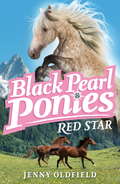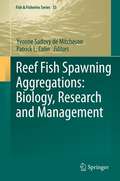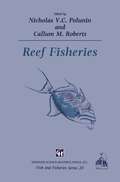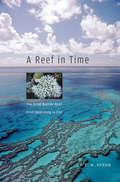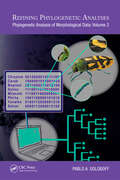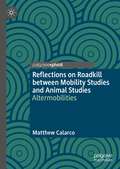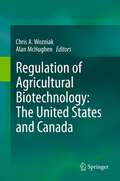- Table View
- List View
Red Snapper Biology in a Changing World (CRC Marine Biology Series)
by Stephen T. Szedlmayer Stephen A. BortoneRed Snapper Lutjanus campechanus, is an important commercial and recreational fish species and there has been much interest in maintaining its status among a variety of scientific, social and economic levels. Stocks are influenced by varying environmental conditions, changing fishing effort and efficiency, anthropogenic effects, inter- and intraspecific interactions, bycatch from other fisheries, and habitat alterations. Red Snapper Biology in a Changing World explores these changing factors and their potential effects on Red Snapper in the Eastern Atlantic region including the Gulf of Mexico and Southeastern U.S. The book will provide a better understanding of Red Snapper population fluctuations that will subsequently allow for better management decisions and more informed user groups in their efforts to maintain a sustainable fishery. It explores the responses Red Snapper have made, and are making, relative to their life history attributes such as early life history and adult ecology, especially attributes associated with population distribution and abundance, movement patterns, fish health issues and management success. A compendium of many papers presented at the 147th annual meeting of the American Fisheries Society in Tampa, Florida, this volume also includes additional research completed as a result of the symposium. It will be essential reading for fisheries scientists and managers, ichthyologists, resource and environmental managers, and policymakers who are involved with coastal fisheries.
Red Squirrel (Large Print)
In this image a red squirrel sits upright on its hind legs. There is a locator dot shown, which will be at the top left of the page when the image is the right way up. It is shown from the side, but its head is turned to face you, so both its ears and eyes can be found. Its head is on the right of the page and tail on the left. The squirrel has two pointed ears on top of its head, each with a tuft of hair on the end. Directly down from this are the squirrel's large eyes on each side of its head. Down again is its nose and mouth. To the left is the squirrel's neck and body. The squirrel has red fur and a white chest and tummy. Both of its forearms can be found; directly below this are both its hind legs. To the left of its legs is the squirrel's big fluffy tail.
Red Squirrel (UEB Contracted)
In this image a red squirrel sits upright on its hind legs. There is a locator dot shown, which will be at the top left of the page when the image is the right way up. It is shown from the side, but its head is turned to face you, so both its ears and eyes can be found. Its head is on the right of the page and tail on the left. The squirrel has two pointed ears on top of its head, each with a tuft of hair on the end. Directly down from this are the squirrel's large eyes on each side of its head. Down again is its nose and mouth. To the left is the squirrel's neck and body. The squirrel has red fur and a white chest and tummy. Both of its forearms can be found; directly below this are both its hind legs. To the left of its legs is the squirrel's big fluffy tail.
Red Squirrel (UEB uncontracted)
In this image a red squirrel sits upright on its hind legs. There is a locator dot shown, which will be at the top left of the page when the image is the right way up. It is shown from the side, but its head is turned to face you, so both its ears and eyes can be found. Its head is on the right of the page and tail on the left. The squirrel has two pointed ears on top of its head, each with a tuft of hair on the end. Directly down from this are the squirrel's large eyes on each side of its head. Down again is its nose and mouth. To the left is the squirrel's neck and body. The squirrel has red fur and a white chest and tummy. Both of its forearms can be found; directly below this are both its hind legs. To the left of its legs is the squirrel's big fluffy tail.
Red Star: Book 1 (Black Pearl Ponies #1)
by Jenny OldfieldRed Star is Keira's own beloved pony - an athletic strawberry roan who is affectionate and loyal and has been part of Keira's life since she was three years old. Keira loves this pony more than anything else in the world - Red Star can do all the cowboy stuff - spins, sliding stops, roping and rounding up cattle. And he seems to read Keira's mind. 'You'd think he was almost human!' big sister Brooke says.So one night when he goes missing, Keira at first thinks he worked out the latch on his stable door and has snuck out looking for feed. But she searches the grain store and the hay barn and can't find him anywhere. Panic sets in - if Red Star took off into the mountains, there are dangers out there for a lone pony - coyotes, bears, even mountain lions. Anyway, he's too smart to get himself into that kind of fix. 'Maybe somebody stole him!' Brooke suggests. So Keira and her family turn detective to track Red Star down.
Redefining Nature: Ecology, Culture and Domestication
by Roy EllenHow can anthropology improve our understanding of the interrelationship between nature and culture?- What can anthropology contribute to practical debates which depend on particular definitions of nature, such as that concerning sustainable development?Humankind has evolved over several million years by living in and utilizing 'nature' and by assimilating it into 'culture'. Indeed, the technological and cultural advancement of the species has been widely acknowledged to rest upon human domination and control of nature. Yet, by the 1960s, the idea of culture in confrontation with nature was being challenged by science, philosophy and the environmental movement. Anthropology is increasingly concerned with such issues as they become more urgent for humankind as a whole. This important book reviews the current state of the concepts of 'nature' we use, both as scientific devices and ideological constructs, and is organised around three themes:- nature as a cultural construction;- the cultural management of the environment; and- relations between plants, animals and humans.
Redefining Nature: Ecology, Culture and Domestication
by Roy Ellen Katsuyoshi FukuiHow can anthropology improve our understanding of the interrelationship between nature and culture?- What can anthropology contribute to practical debates which depend on particular definitions of nature, such as that concerning sustainable development?Humankind has evolved over several million years by living in and utilizing 'nature' and by assimilating it into 'culture'. Indeed, the technological and cultural advancement of the species has been widely acknowledged to rest upon human domination and control of nature. Yet, by the 1960s, the idea of culture in confrontation with nature was being challenged by science, philosophy and the environmental movement. Anthropology is increasingly concerned with such issues as they become more urgent for humankind as a whole. This important book reviews the current state of the concepts of 'nature' we use, both as scientific devices and ideological constructs, and is organised around three themes:- nature as a cultural construction;- the cultural management of the environment; and- relations between plants, animals and humans.
The Redox State and Circadian Rhythms
by Thérèse Vanden Driessche J. L. Guisset G. M. Petiau-De VriesAlthough the term redox covers an important number of chemical reactions, biochemists are more familiar with reactions involving the reactions mediated by electron transfer chains associated with respiration, the thiol-disulfide exchanges and the reactions occurring in the presence of free radicals. More recently, the importance of these reactions in the living world and in medicine has been recognized by biochemists, biologists, physiologists, physicians, etc. The importance of the subject in both fundamental and is reflected by the abundance of interesting reviews applied science concerning the subject (Cadenas, 1989, Del Maestro, 1991) and books (Dreosti, 1991; Rice-Evans and Burdon, 1994; Armstrong, 1994) The aim of this chapter is to describe basic reactions known with references to reviews covering special subjects related to redox reactions. Transformation of energy in living organisms is mediated by complex biological systems such as electron transfer chains where the succession of redox reactions provides energy to the organisms. Molecular oxygen or dioxygen is an essential molecule and is the terminal acceptor of electrons during respiration in eukaryotes. In these organisms, the electron transfer chain is located in the mitochondrial membranes and produces adenosine triphosphate (ATP). In anaerobes, the electron acceptor is C0 , S, sulphate or nitrate ions 2 instead of 02.
Redwall: A Tale From Redwall (Redwall #1)
by Brian JacquesRedwall Abbey, tranquil home to a community of peace-loving mice is threatened by Cluny the Scourge - the evil-one-eyed rat warlord - and his battle-hardened horde of predators. Cluny is certain that Redwall will fall easily to his fearsome army but he hasn't bargained for the courage and strength of the combined forces of the Redwall mice and their loyal woodland friends. . . . .
Reef Fish Spawning Aggregations: Biology, Research and Management (Fish & Fisheries Series #35)
by Yvonne Sadovy Sadovy de Mitcheson and Patrick L. L. ColinReef fish spawning aggregations, ranging from small groups to many tens of thousands of individuals, are spectacular but poorly known natural phenomena whereby fish assemble at specific times and locations to spawn. For some species these large groups may be the only form of reproduction, the high fish numbers briefly giving a false impression of stability and abundance—an ‘illusion of plenty’. They are often a focus for intensive seasonal fishing because of their predictability and because many important commercial fishes form them. Highly vulnerable to overexploitation, many aggregations and their associated fisheries, have disappeared or are in decline. Few are effectively managed or incorporated into protected areas. Aggregations are not well understood by fishery scientists, managers and conservationists and their significance little appreciated by fishers or the wider public. To ensure their persistence to replenish important fisheries in coral ecosystems, maintain their ecosystem function and continue to delight divers, a significant change in perspective is needed to foster protection and management. This book provides comprehensive and practical coverage of the biology, study and management of reef fish aggregations, exploring their how, when, where, and why. It explores ways to better protect, study, manage and conserve them, while identifying key data gaps and questions. The text is extensively illustrated with many unique, never before published, photographs and graphics. Case studies on over 20 interesting and important fishes are included, outlining their biology and fisheries and highlighting major concerns and challenges.
Reef Fisheries (Fish & Fisheries Series #20)
by Polunin Nicholas V. C. C. RobertsReef ecosystems extend throughout the tropics. Exploited by small-scale fishers, reefs supply food for millions of people, but, worldwide, there are growing worries about the productivity and current state of these ecosystems. Reef fish stocks display many features of fisheries elsewhere. However, habitat spatial complexity, biological diversity within and among species, ecosystem intricacy and variable means of exploitation make it hard to predict sustainable modes and levels of fishing.
A Reef in Time: The Great Barrier Reef from Beginning to End
by J.E.N. VeronLike many coral specialists fifteen years ago, J.E.N. Veron thought Australia’s Great Barrier Reef was impervious to climate change. “Owned by a prosperous country and accorded the protection it deserves, it would surely not go the way of the Amazon rain forest or the parklands of Africa, but would endure forever. That is what I thought once, but I think it no longer.” This book is Veron’s Silent Spring for the world’s coral reefs. Veron presents the geological history of the reef, the biology of coral reef ecosystems, and a primer on what we know about climate change. He concludes that the Great Barrier Reef and, indeed, most coral reefs will be dead from mass bleaching and irreversible acidification within the coming century unless greenhouse gas emissions are curbed. If we don’t have the political will to confront the plight of the world’s reefs, he argues, current processes already in motion will become unstoppable, bringing on a mass extinction the world has not seen for 65 million years. Our species has cracked its own genetic code and sent representatives of its kind to the moon—we can certainly save the world’s reefs if we want to. But to achieve this goal, we must devote scientific expertise and political muscle to the development of green technologies that will dramatically reduce greenhouse emissions and reverse acidification of the oceans.
Refining Phylogenetic Analyses: Phylogenetic Analysis of Morphological Data: Volume 2 (Species and Systematics)
by Pablo A. GoloboffThis volume discusses the aspects of a phylogenetic analysis that go beyond basic calculation of most parsimonious trees. Practical application of all principles discussed is illustrated by reference to TNT, a freely available software package that can perform all the steps needed in a phylogenetic analysis. The first problem considered is how to summarize and compare multiple trees (including identification and handling wildcard taxa). Evaluation of the strength of support for groups, another critical component of any phylogenetic analysis, is given careful consideration. The different interpretations of measures of support are discussed and connected with alternative implementations. The book reviews rationales for estimating character reliability on the basis of homoplasy, with particular attention to morphological characters. The main methods for character weighting and their practical implementation, several of them unique to TNT, are discussed ad libitum. Also unique to TNT is the ability to directly analyze morphometric data (including landmarks), on the same footing as discrete characters. Finally, the scripting language of TNT is introduced. With scripting, it is possible to "program" TNT to create personalized routines and automate complex calculations, taking analyses to the next level and allowing exploration of new methods and ideas.Key Features Discusses the treatment of ambiguity in phylogenetic analyses in depth, for summarizing results or comparing trees Reviews literature on arguments and methods for weighting morphological characters and their practical application Describes theory and application of methods for evaluating strength of group support, based on either resampling or comparisons with suboptimal trees Discusses the use of morphometric characters in phylogenetic analysis Presents extensive information on commands and options of the TNT computer program, including the use and creation of scripts
Refining Phylogenetic Analyses: Phylogenetic Analysis of Morphological Data: Volume 2 (Species and Systematics)
by Pablo A. GoloboffThis volume discusses the aspects of a phylogenetic analysis that go beyond basic calculation of most parsimonious trees. Practical application of all principles discussed is illustrated by reference to TNT, a freely available software package that can perform all the steps needed in a phylogenetic analysis. The first problem considered is how to summarize and compare multiple trees (including identification and handling wildcard taxa). Evaluation of the strength of support for groups, another critical component of any phylogenetic analysis, is given careful consideration. The different interpretations of measures of support are discussed and connected with alternative implementations. The book reviews rationales for estimating character reliability on the basis of homoplasy, with particular attention to morphological characters. The main methods for character weighting and their practical implementation, several of them unique to TNT, are discussed ad libitum. Also unique to TNT is the ability to directly analyze morphometric data (including landmarks), on the same footing as discrete characters. Finally, the scripting language of TNT is introduced. With scripting, it is possible to "program" TNT to create personalized routines and automate complex calculations, taking analyses to the next level and allowing exploration of new methods and ideas.Key Features Discusses the treatment of ambiguity in phylogenetic analyses in depth, for summarizing results or comparing trees Reviews literature on arguments and methods for weighting morphological characters and their practical application Describes theory and application of methods for evaluating strength of group support, based on either resampling or comparisons with suboptimal trees Discusses the use of morphometric characters in phylogenetic analysis Presents extensive information on commands and options of the TNT computer program, including the use and creation of scripts
Reflections on Roadkill between Mobility Studies and Animal Studies: Altermobilities
by Matthew CalarcoRoadkill is a recurrent but often unthought feature of modern life. Yet, consideration of the broader significance of the myriad social, ethical, and political issues related to roadkill has largely gone missing from mainstream scholarship and activism. This neglect persists even in fields such as mobility studies and animal studies that would otherwise seem to have a vested interest in the topic. This book aims to bring roadkill to the foreground of current discussions among scholars and activists in these fields in order to demonstrate that roadkill is a uniquely important site from which to understand and contest the machinations of the dominant social order. It argues that a careful examination of roadkill can help both to uncover the hidden violence of contemporary human-centered systems of mobility and to develop alternative modes of mobility for a renewed social life in common with our more-than-human kin.
Regeneration of Plants in Arid Ecosystems Resulting from Patch Disturbance (Geobotany #27)
by Yitzchak GuttermanThe main subject of this book is the interaction between diggings created by porcupines when consuming geophytes, and their influences on annual and perennial vegetation in a desert biome. The accumulation of run-off water in diggings and depressions made by animals increases the carrying capacity of these microhabitats in the desert biome. The accumulation of run-off water does not only benefit the natural vegetation; a system of human-made depressions can be evolved to increase the catchment of the run-off water that is typical to many desert habitats, and can lead to run-off agriculture in such areas. This book will be of interest to anyone working in the fields of development of deserts from the ecological point of view, water resources, soil protection and erosion, plant ecophysiology and settlement, and agronomy. It will be helpful to students, researchers, teachers, and anyone interested in any of these areas.
Regenerative Farming and Sustainable Diets: Human, Animal and Planetary Health (Earthscan Food and Agriculture)
by Joyce D’Silva Carol McKennaThis book makes the case for an urgent move away from industrial agriculture towards regenerative farming and the promotion of plant-based diets.How we produce, distribute and consume food are critical issues for the health and well-being of humans, animals and the environment. In order to develop a sustainable food system, this book argues for a radical change in farming and food consumption. Containing contributions from world renowned experts, this book promotes regenerative farming as the means to preserve planetary health, establish sustainable, healthy and secure diets and safeguard the welfare of animals. Chapters discuss broad ranging issues from climate change and biodiversity conservation to animal sentience and intensive farming, and the role of financial markets and food businesses. The book concludes with chapters discussing the routes in policy and practice to transforming the food system and achieving real-world change.This book is a must read for students, scholars and policymakers interested in establishing sustainable farming and food systems, for human health, animal welfare and environmental protection.
Regenerative Farming and Sustainable Diets: Human, Animal and Planetary Health (Earthscan Food and Agriculture)
This book makes the case for an urgent move away from industrial agriculture towards regenerative farming and the promotion of plant-based diets.How we produce, distribute and consume food are critical issues for the health and well-being of humans, animals and the environment. In order to develop a sustainable food system, this book argues for a radical change in farming and food consumption. Containing contributions from world renowned experts, this book promotes regenerative farming as the means to preserve planetary health, establish sustainable, healthy and secure diets and safeguard the welfare of animals. Chapters discuss broad ranging issues from climate change and biodiversity conservation to animal sentience and intensive farming, and the role of financial markets and food businesses. The book concludes with chapters discussing the routes in policy and practice to transforming the food system and achieving real-world change.This book is a must read for students, scholars and policymakers interested in establishing sustainable farming and food systems, for human health, animal welfare and environmental protection.
Regieren in Koalitionen: Handlungsmuster und Entscheidungsbildung in deutschen Länderregierungen
by Sabine KroppGegenstand der Untersuchung ist eine vergleichende Analyse der Entscheidungspraxis von Länderkoalitionen.Gerade die deutschen Länderregierungen bieten die Möglichkeit, auf der Grundlage weitgehend gleicher institutioneller Rahmenbedingungen die Entscheidungspraxis von Regierungsbündnissen vergleichend zu untersuchen. Die Arbeit stellt anhand von Haushaltsentscheidungsprozessen dar, welcher Strategien sich Koalitionsparteien bedienen, um Konsens mit dem Partner herzustellen und sich gleichzeitig eigene Vorteile zu sichern. Daneben wird gezeigt, wie Koalitionshandeln auch eine innerparteiliche und föderale Entscheidungsebene einschließt. Diese Ebenen werden bei Entscheidungsprozessen ins Kalkül der Akteure einbezogen. Schließlich wird die Frage diskutiert, inwieweit sich aus der empirischen Analyse von Koalitionshandeln theoretische Erklärungsmuster gewinnen lassen.
Regional Fisheries Management Organizations: The interplay between governance and science
by Leandra R. GonçalvesThis book analyzes empirical data from three specific Regional Fisheries Management Organizations (RFMOs) designed to establish rules for the conservation and management of fish stocks in the ocean, in order to assess their effectiveness in converting science into policy for the recovery and maintenance of fishery populations. The three RFMOs discussed are the CCAMLR (Convention for the Conservation of Antarctic Marine Living Resources), the ICCAT (International Commission for the Conservation of Atlantic Tunas) and the CCSBT (Commission for the Conservation of Southern Bluefin Tuna). The book seeks to understand when governments choose to listen to science, and establishes a framework to examine the institutional designs currently in place to accommodate RFMO policy suggestions and the conditions under which they are implemented successfully. The study will be of interest to academics and professionals broadly interested in global environmental governance and international relations, and will specifically appeal to policymakers, conservationists, and environmental researchers interested in fishery management and policy at the global and regional scale. Gonçalves provides an accessible and comprehensive analysis of RMFOs. She offers valuable insights into the role of science and politics in shaping sustainable fisheries policies for the open oceans. ---Peter M Haas, Professor Department of Political Science, University of Massachusetts AmherstAs envisaged by the UN Decade of Ocean proclamation, this book is an important and sincere effort, hopefully to be accompanied by many others to come during this promising decade, that will help to build a common framework to ensure that ocean science can support countries and the international community in creating improved conditions for the sustainable development of our cherished Ocean.---Fabio H. Hazin - Professor at Federal Rural University of Pernambuco, Brazil
Regional Fisheries Oceanography of the California Current System: The CalCOFI program
by Sam McClatchieThe California Current System is one of the best studied ocean regions of the world, and the level of oceanographic information available is perhaps only surpassed by the northeast and northwest Atlantic. The current literature (later than 1993) offers no comprehensive, integrated review of the regional fisheries oceanography of the California Current System.This volume summarizes information of more than 60-year California Cooperative Oceanic Fisheries Investigation (CalCOFI). While providing a large bibliography, the intent was to extract themes relevant to current research rather than to prepare a compendious review of the literature. The work presents a useful review and reference point for multidisciplinary fisheries scientists and biological oceanographers new to working in the California Current System, and to specialists wishing to access information outside their core areas of expertise. In addition it aims to deliver an up to date reference to the current state of knowledge of fisheries oceanography in the California Current System.
Regulation of Agricultural Biotechnology: The United States and Canada
by Chris A. Wozniak and Alan McHughenAgricultural biotechnology takes many forms and applications, with the number and diversity of products ever increasing. With this rapid development, regulatory authorities have sought to keep pace through regulatory adjustments and advances to ensure the safe and beneficial use of this critical technology. The regulatory systems for the U.S. and Canada are not static and must evolve in order to maintain relevance, efficiency and applicability to the challenges encountered. The diverse authors, drawn from the biotechnology industry, academia, government research and regulatory agencies, offer their perspectives of the historical and current system and suggest where it can be improved in the future. Based upon vast experience interacting with the regulatory system, the editors and authors offer demystifying views of the US and Canadian regulatory structures and how they came to be. We know of no other effort to present the biotechnology regulatory systems of the US and Canada in an open forum which will benefit those in the regulated community as well as those charged with oversight of the products of biotechnology, and ultimately the consumer!
Regulation of Alternative Splicing (Progress in Molecular and Subcellular Biology #31)
by Philippe JeanteurThe discovery in 1977 that genes are split into exons and introns has done away with the one gene - one protein dogma. Indeed, the removal of introns from the primary RNA transcript is not necessarily straightforward since there may be optional pathways leading to different messenger RNAs and consequently to different proteins. Examples of such an alternative splicing mechanism cover all fields of biology. Moreover, there are plenty of occurrences where deviant splicing can have pathological effects. Despite the high number of specific cases of alternative splicing, it was not until recently that the generality and extent of this phenomenon was fully appreciated. A superficial reading of the preliminary sequence of the human genome published in 2001 led to the surprising, and even deceiving to many scientists, low number of genes (around 32,000) which contrasted with the much higher figure around 150,000 which was previously envisioned. Attempts to make a global assessment of the use of alternative splicing are recent and rely essentially on the comparison of genomic mRNA and EST sequences as reviewed by Thanaraj and Stamm in the first chapter of this volume. Most recent estimates suggest that 40-60% of human genes might be alternatively spliced, as opposed to about 22% for C. elegans.
The Regulation of Animal Health and Welfare: Science, Law and Policy (Law, Science and Society)
by John McEldowney Wyn Grant Graham MedleyThe Regulation of Animal Health and Welfare draws on the research of scientists, lawyers, economists and political scientists to address the current and future regulatory problems posed by the issues of animal health and disease. Recent events such as the outbreak of mad cow disease, epidemics of foot and mouth disease, concerns about bluetongue in sheep, and the entry into the food chain of the offspring of cloned cattle, have heightened awareness of the issues of regulation in animal disease and welfare. This book critically appraises the existing regulatory institutions and guiding principles of how best to maintain animal health in the context of social change and a developing global economy. Addressing considerations of sound science, the role of risk management, and the allocation of responsibilities, it also takes up the theoretical and practical challenges which here – and elsewhere – attend the co-operation of scientists, social scientists, lawyers and policy makers. Indeed, the collaboration of scientists and social scientists in determined and regulatory contexts such as that of animal disease is an issue of ever-increasing importance. This book will be of considerable value to those with interests in this issue, as well as those concerned with the law and policy relating to animal health and welfare.
The Regulation of Animal Health and Welfare: Science, Law and Policy (Law, Science and Society)
by John McEldowney Wyn Grant Graham MedleyThe Regulation of Animal Health and Welfare draws on the research of scientists, lawyers, economists and political scientists to address the current and future regulatory problems posed by the issues of animal health and disease. Recent events such as the outbreak of mad cow disease, epidemics of foot and mouth disease, concerns about bluetongue in sheep, and the entry into the food chain of the offspring of cloned cattle, have heightened awareness of the issues of regulation in animal disease and welfare. This book critically appraises the existing regulatory institutions and guiding principles of how best to maintain animal health in the context of social change and a developing global economy. Addressing considerations of sound science, the role of risk management, and the allocation of responsibilities, it also takes up the theoretical and practical challenges which here – and elsewhere – attend the co-operation of scientists, social scientists, lawyers and policy makers. Indeed, the collaboration of scientists and social scientists in determined and regulatory contexts such as that of animal disease is an issue of ever-increasing importance. This book will be of considerable value to those with interests in this issue, as well as those concerned with the law and policy relating to animal health and welfare.


